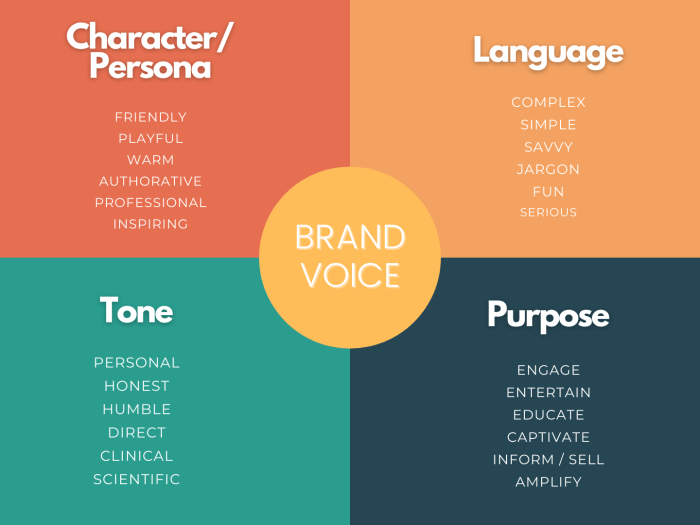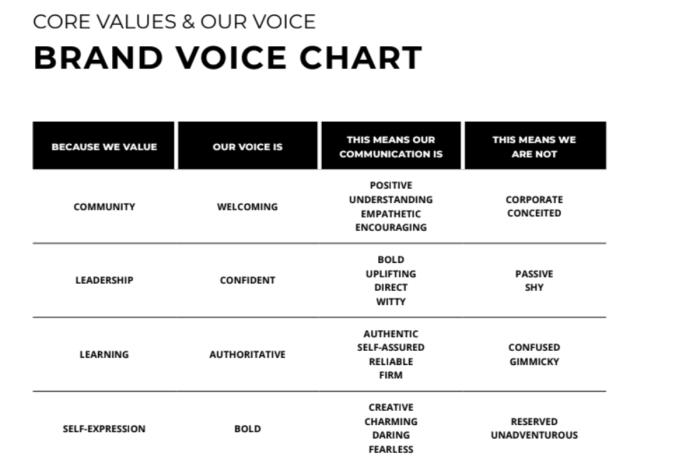Creating a Brand Voice sets the stage for defining what makes your business stand out, capturing the essence of your brand in a way that resonates with your audience. Dive into the world of brand identity and voice with us.
Understanding Brand Voice

Brand voice is the unique personality and style of a brand that is conveyed through its messaging and communication. It’s important for a business because it helps establish a connection with customers, build brand recognition, and differentiate the brand from competitors.
Setting Apart from Competitors
- Brand voice sets a company apart from competitors by creating a distinct identity that resonates with the target audience.
- It helps customers recognize and remember the brand, leading to increased brand loyalty and preference.
- Consistent brand voice builds trust and credibility, making the brand more memorable in the minds of consumers.
Examples of Successful Brand Voices
- Apple: Known for its minimalist and innovative brand voice that emphasizes simplicity and cutting-edge technology.
- Nike: Empowering and motivational brand voice that encourages consumers to push beyond their limits and strive for greatness.
- Disney: Magical and whimsical brand voice that appeals to both children and adults, evoking feelings of nostalgia and happiness.
Impact on Customer Loyalty
- A consistent brand voice helps create a strong emotional connection with customers, leading to increased loyalty and repeat business.
- Customers are more likely to trust and engage with a brand that maintains a consistent voice across all communication channels.
- Brand voice reinforces brand values and messaging, making it easier for customers to identify with and relate to the brand.
Developing Your Brand Voice

Creating a unique brand voice involves identifying your brand’s values, personality, and target audience. By understanding these key elements, you can create a brand voice that resonates with your audience and aligns with your brand’s identity.
Identifying Your Brand’s Values, Personality, and Target Audience
To develop your brand voice, start by clearly defining your brand’s values – what does your brand stand for? Next, identify your brand’s personality traits – is your brand fun and quirky or serious and professional? Lastly, understand your target audience – who are they, what do they care about, and how do they communicate?
- Conduct market research to gather insights on your target audience’s preferences and behaviors.
- Define your brand’s core values and ensure they are reflected in your brand voice.
- Determine your brand’s personality traits and use them to guide your tone and language.
- Create buyer personas to better understand and connect with your target audience.
Creating a Brand Voice that Aligns with Your Brand’s Identity
Once you have a clear understanding of your brand’s values, personality, and target audience, it’s time to create a brand voice that aligns with your brand’s identity. Your brand voice should be consistent, authentic, and recognizable across all communication channels.
- Develop brand voice guidelines to maintain consistency in tone, language, and messaging.
- Tailor your brand voice to suit different communication channels while ensuring coherence.
- Use storytelling to convey your brand’s values and connect with your audience on a deeper level.
- Regularly review and refine your brand voice based on feedback and market trends.
Maintaining Coherence Across Different Communication Channels, Creating a Brand Voice
To maintain coherence across different communication channels, ensure that your brand voice remains consistent in tone, language, and messaging. Whether you’re communicating through social media, email marketing, or in-person interactions, your brand voice should always reflect your brand’s identity and values.
- Create brand voice style guides to provide direction for content creators and ensure consistency.
- Tailor your messaging to suit each communication channel while maintaining a cohesive brand voice.
- Monitor feedback and engagement to gauge the effectiveness of your brand voice across different channels.
- Train your team members to embody your brand voice in their interactions with customers and stakeholders.
The Role of Market Research in Shaping Your Brand Voice
Market research plays a crucial role in shaping your brand voice by providing valuable insights into your target audience’s preferences, behaviors, and communication habits. By conducting thorough market research, you can better understand your audience and tailor your brand voice to resonate with them effectively.
- Use surveys, focus groups, and social listening tools to gather data on your target audience.
- Analyze competitor strategies and industry trends to identify gaps and opportunities for your brand voice.
- Test different brand voice approaches through A/B testing and gather feedback to refine your strategy.
- Stay updated on market changes and customer feedback to adapt your brand voice accordingly.
Implementing Brand Voice in Content: Creating A Brand Voice
Incorporating a brand voice in various types of content is crucial for creating a consistent and recognizable identity for your brand. From website copy to social media posts and marketing materials, every piece of content should reflect your brand’s unique voice and personality.
Website Copy
When writing website copy, it’s essential to use language and tone that align with your brand’s voice. Whether your brand is playful and casual or professional and authoritative, make sure the content on your website reflects this. Use consistent messaging, style, and vocabulary to create a cohesive brand experience for visitors.
Social Media Posts
Social media is a great platform to showcase your brand voice in a more informal and engaging way. Tailor your posts to resonate with your target audience, using humor, emojis, or trending hashtags if they align with your brand persona. Remember to maintain consistency across all platforms to reinforce brand recognition.
Marketing Materials
Incorporating your brand voice into marketing materials like brochures, flyers, or advertisements is essential for creating a lasting impression on your audience. Use storytelling techniques to convey your brand’s message effectively and emotionally connect with your customers. Consistent use of language, visuals, and design elements will strengthen your brand identity.
Importance of Storytelling
Storytelling plays a crucial role in conveying your brand’s message and voice. By sharing authentic stories and experiences, you can create a deeper connection with your audience and differentiate your brand from competitors. Incorporating storytelling in your content humanizes your brand and makes it more relatable to consumers.
Adapting Brand Voice for Different Platforms
It’s essential to adapt your brand voice for different platforms and audiences while maintaining consistency. Tailor your tone, language, and style to fit the specific platform’s requirements and the preferences of your target audience. Whether you’re posting on Instagram, Twitter, or LinkedIn, make sure your brand voice remains authentic and recognizable.
Evolving Brand Voice Over Time
In today’s ever-changing market, it is crucial for brands to evolve their voice over time in order to stay relevant and resonate with their target audience. As consumer preferences, trends, and competition shift, brands must adapt and refresh their voice to maintain a strong connection with their customers.
Reasons for Brand Voice Evolution
- Market Trends: Changes in consumer behavior and preferences may require a brand to update its voice to stay current.
- Brand Growth: As a brand expands its offerings or enters new markets, its voice may need to evolve to reflect these changes.
- Competition: To stand out in a crowded market, a brand may need to refresh its voice to differentiate itself from competitors.
Strategies for Refreshing Brand Voice
- Conduct Market Research: Gather feedback from customers and analyze market trends to identify areas for improvement.
- Define Brand Values: Clearly Artikel the core values and personality traits that should be reflected in the brand’s voice.
- Collaborate with Stakeholders: Involve key stakeholders in the process to ensure alignment with the brand’s overall vision.
Communicating Changes to Stakeholders
- Transparency: Be open and honest about the reasons for the change and how it aligns with the brand’s long-term goals.
- Consistency: Ensure that the new brand voice is consistently applied across all channels to avoid confusion.
- Solicit Feedback: Encourage feedback from customers and stakeholders to gauge their response to the updated voice.
Examples of Successful Brand Voice Evolution
-
Apple:
Apple successfully evolved its brand voice from a tech-focused company to a lifestyle brand, emphasizing simplicity and creativity.
-
Nike:
Nike shifted its brand voice from being solely focused on sports performance to inspiring and empowering athletes of all levels.
-
Starbucks:
Starbucks updated its brand voice to focus on sustainability and community engagement, aligning with changing consumer values.